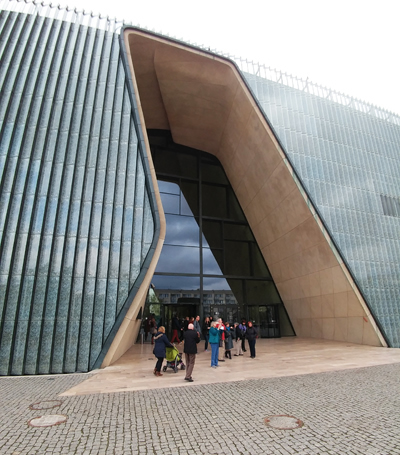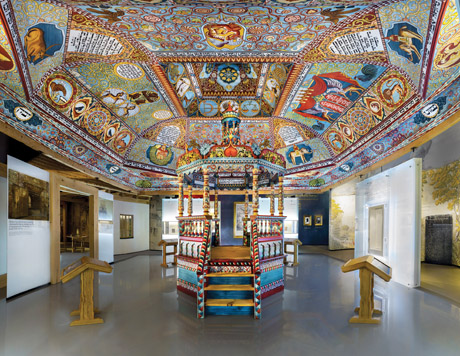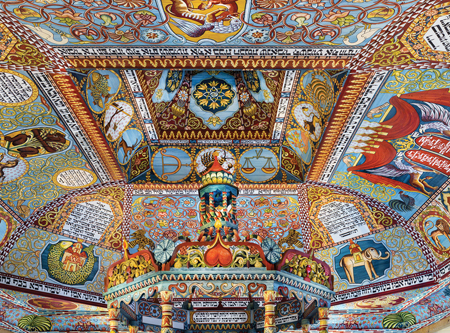Art Essay: Polin A State-of-the-Art Museum of the History of Polish Jews in Warsaw Poland
By Mark Laiosa
arttimesjournal June 17, 2017
 Exterior of Polin Museum (Photo Mark Laiosa) |
The Polin Museum opened in 2013 and is an important addition to Warsaw's history museums, using state-of-the-art museum technology to provide an overview of approximately 1000 years of Polish Jewish History. The building sits within the boundaries of the Warsaw Ghetto and a counterpoint to Leon Suzin's 1948 Monument to the Ghetto Heroes. The museum building was designed by Finnish architects Rainer Mahlamaki and Ilmari Lahdelma.
The wide Museum is clad in glass, with an asymmetrical shaped entrance that narrows towards the roof. A cafe and club are below ground level and have a separate entrance. An art studio with large glass windows occupies one corner of the building. The entrance has a security check and a slight incline under curved ceilings that are the exterior walls of the auditorium, lecture halls, and conference center, with state-of-the-art audio-visual, and digital facilities. It received the Association of Polish Architects Award in 2014, and in 2016 was the European Museum of the Year.
The eight galleries form the core exhibition and tells the story of the Jewish people in Poland; it's a melding of museology and stagecraft.
A descending staircase broadens as you enter the lower level to the first gallery, and the legend of Jewish traveling merchants in a fog-shrouded forest came across a tree with a marking interpreted as “Polin,” Hebrew for “rest here” and the Hebrew name for Poland.
Jewish settlements developed. The oldest artifact in the museum, a 13th Century coin with Hebrew letters is on display. You can virtually mint your own coin by setting your Hebrew name or a transliteration, and optional blessing onto a virtual coin via an on-screen computer that translates roman letters into Hebrew. A tap on the screen and your coin appears, name and blessings, suitable for a photo.
 One of the Galleries in the Museum (Photo Mark Laiosa) |
Another hands-on experience, literally, a hand press to print a title page or printer's mark from an early book. Multi-lingual docents will help you if needed, to make your print. The travels of the Jewish people is illustrated with a large map showing the migration of Jews from Western Europe and the Caliphate to central Europe along trading routes. Slowly Jews move into designated areas of medieval cities and various charters that proscribe occupations and limits of Jewish activities. In another gallery Klezmer music comes from behind a set of life-sized cut-out musicians.
The reflective nature of Jews in Poland is a history of Poland itself. During the Polish-Lithuanian Commonwealth, Jews were allowed self rule on local, regional, and national level. The Commonwealth was a safe haven from the nearby religious wars of Western Europe to the extent that by the late 18th century the Commonwealth had the largest Jewish population in the world, and by managing and using their skills contributed to the success of the nobility's latifundia - private towns and estates. This changed with the partition of the Commonwealth. Depending on their region, Jews were subject to the laws of Russia, Prussia, or Austria. A large gallery with three portraits of the rulers dominate the room. A touch screen shows the requirements to live in each partition.
 Duplication of a synagogue from Gwozdziec (now Ukraine). The Bema (photo credit M. Starowieyoka_D. Golik.) |
One highlight is a duplication of a synagogue from Gwozdziec (now Ukraine). The Bema, a raised platform for Torah readings, is painted with primary colors that dominate a dazzling array of patterns, topped by a ceiling with zodiac signs and animals. The artist used his or her imagination in depicting an elephant - a dachshund with tusks and trunk. Over four hundred volunteers from around the world used traditional methods in its re-creation. A sound element of a liturgical reading enhances the sense of place. The color and sounds bring the installation to life.
With the industrial revolution, the railways provided quick movement of people, ideas, integration and emigration. You can “purchase” tickets at the booth and read the impressions these early train travelers experienced, like one who wrote, “It's busy and many people, how will I find my way?”
The aftermath of World War One and the birth of the Second Polish Republic brought new realities. Explore the Jewish Street, entering doorways into homes and taverns to see what daily life was for Jews, or open desk tops to see what the different school experiences were across the Second Republic. Literary and the creative side of Jewish life is displayed in Cafe Ziemianska, where you can dance along with music from a gramophone and watch a humorous short animated film clip.
 Detail of synagogue from Gwozdziec (now Ukraine). (Photo Mark Laiosa) |
Part of the Jewish millennial history are the six years of gradual repression culminating in the Holocaust, just as casually turning a corner of Jewish Street, you come face to face with the German blitzkrieg and then the Soviet Union's invasion. The challenge to many Poles and their response with the use of many artifacts ranged from help and resistance, to indifference, or cooperation with forces of repression. Among the artifacts a secret archive of the Warsaw ghetto and uprising.
Post World War Two found the Jewish population decimated and Polish society shredded by the Nazi's total war and the Soviet's atrocities. Exhibits show the stress on Polish Jews to stay and rebuild Poland or build a new life in the British Mandate of Palestine.
Communist Poland is depicted as a culture of limited consumer goods and limited expressions of Judaism. The exhibit brings it to life with black and white television images and blaring sounds of the 1968 anti-Semitic speeches at a volume that makes you physically uncomfortable. For the remaining Jews, the untenable firings and slander created a tension that caused many Jews to leave with the understanding that they lose their Polish citizenship.
After Communism
Video and audio interviews are used to tell about life as a Jew in present day Poland, or ask compelling questions. “did you always know you were Jewish? Or how has life changed since you learned you were Jewish?”
A docent mentioned that since the end of the communist period, there is a growing interest among Poles to explore their roots. The resource center complete with databases, genealogy, and information on the local Jewish community can help. There are workshops and specialist consultations available.
The lower level is the home of Besamim Restauracja. Besamim, Hebrew for spices, serves Jewish and international cuisine, Israeli wines, Kosher foods, and a take out menu.
Currently there is a small return of Jews to Poland and the complex issues of financial and property restitution that will be part of the Museum's next chapter.
For more information, go to polin.pl/en
